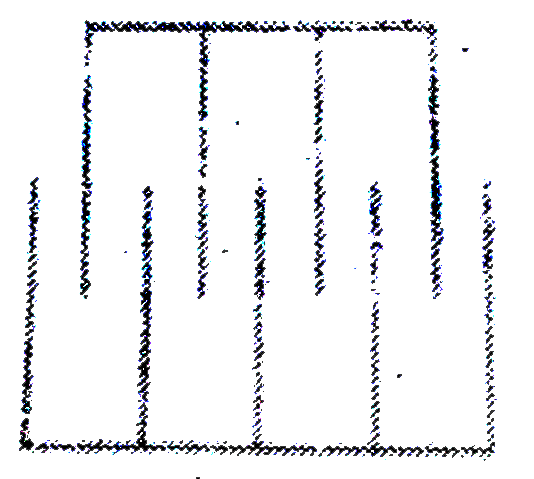A gang capacitor is formed by interlocking a number of plates as shown in figure. The distance between the consecutive plate is 0.885 cm and the overlapping area of the plates is 5cm2. The capacity of the unit is
 Solution in Bengali
Solution in Bengali
1.06 pF
4 pF
6.36 pF
12.72 pF
The correct Answer is:B
Step by step video, text & image solution for A gang capacitor is formed by interlocking a number of plates as shown in figure. The distance between the consecutive plate is 0.885 cm and the overlapping area of the plates is 5cm^2. The capacity of the unit is by Physics experts to help you in doubts & scoring excellent marks in Class 12 exams.
Updated on:21/07/2023Topper's Solved these Questions
- ELECTROSTATIC POTENTIAL AND CAPACITANCEBOOK - PATHFINDERCHAPTER - ELECTROSTATIC POTENTIAL AND CAPACITANCEEXERCISE - QUESTION BANK
50 Videos
- MAGNETIC EFFECT OF CURRENT AND ELECTROMAGNETISM-I,II AND IIIBOOK - PATHFINDERCHAPTER - MAGNETIC EFFECT OF CURRENT AND ELECTROMAGNETISM-I,II AND IIIEXERCISE - QUESTION BANK
213 Videos
Similar Questions
Can two equipotential surfaces intersect?
View SolutionA wire placed along north south direction carries a current of 10A from south to north find the magnetic field due to a 1 cm piece of wire at a point 200cm north east from the piece
View SolutionThe expression for the capacity of the capacitor formed by compound dielectric placed between the plates of a parallel plate capacitor as shown in figure, will be (area of plate =A)

View SolutionA gang capacitor is formed by interlocking a number of plates as shown in figure. The distance between the consecutive plates is 0.885 cm annd the overlapping area of the plates is 5 cm2. The capacity of the unit is

View SolutionThe expression for the capacity of the capacitor formed by compound dielectric placed between the plates of a parallel plate capacitor as shown in figure will be

View SolutionThe capacity of a parallel plate capacitor formed by the plates of same area A is 0.02mu F with air as dielectric.Now one plate is replaced by a plate of area 2A and dielectric (K=2) is introduced between the plates the capacity is...
View SolutionA gang capacitor is formed by interlocking a number of plates as shown in figure. The distance between the consecutive plates is 0.885 cm and the overlapping area of the plates is 5cm^(2) . The capacity of the unit is
View SolutionThe expression for the capacity of a capacitor formed by placing a compound dieletric between the plates of a parallel plate capacitor, as shown in figure , will be (Given area of plate = A)

View SolutionThe capacity of a parallel plate capacitor is 10 muF , when the distance between its plates is 8 cm. If the distance between the plates is reduced to 4 cm, the new capacity of the parallel plate capacitor will be
View Solutionचित्र में प्रदर्शित संधारित्र की प्लेटो का क्षेत्रफल A1 तथा A2(A1<A2) है तथा प्लेटो के बीच की दूरी d है। संधारित्र की धारित्र ज्ञात कीजिए।
View SolutionThe capacity of a parallel plate capacitor formed by the plates of same area A is 0.02μF with air as dielectric. Now one plate is replaced by a plate of area 2A and dielectric (k=2) is introduced between the plates, the capacity is
View SolutionA gang capacitor is formed by interlocking a number of plates as shown in figure. The distance between the consecutive plates is 0.885 cm annd the overlapping area of the plates is 5 cm^(2) . The capacity of the unit is
View Solutionचित्रानुसार एक समूह संधारित्र का निर्माण अनेक सारी प्लेटों की इन्टरलॉकिंग से होता है। क्रमिक प्लेटों (Consecutive plates) के मध्य की दूरी 0.885 cm है तथा प्लेटों का अतिव्याप्त क्षेत्र 5cm2 है। इकाई (Unit) की धारिता है

View SolutionThe expression for the capacity of the capacitor formed by compound dielectric placed between the plates of a parallel plate capacitor as shown in figure, will be (area of plate = A )
View SolutionWhat is the area of the plates of a parallel plate capacitor of capacity 2pF with separation between the plates 0.5 cm?
View Solution
